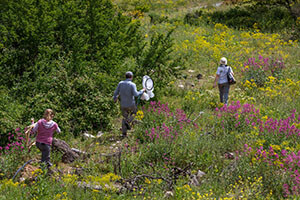
Over the past few months, I’ve been receiving lots of questions from beekeepers, land managers, and conservation folks about competition between managed honey bees and native wild bees.
Perhaps this isn’t surprising since it’s becoming more and more difficult for U.S. beekeepers to find suitable land where they can place their hives. This has resulted in major beekeeping organizations working to gain or maintain access to public lands (e.g., national forests) for their beekeeper constituents. In turn, several conservation groups have worked to block access due to the potential for negative impacts on native wild bees.
The crux of this debate hinges on when competition actually occurs between honey bees and native bees. In other words, when do managed honey bees collect so much pollen and nectar from flowers that there isn’t enough left for native wild bees? Is it common? Rare? Are there particular times of the year when competition for resources is more or less likely? These are the topics for the fifty-first Notes from the Lab, where I summarize “Seasonal dynamics of competition between honey bees and wild bees in a protected Mediterranean scrubland,” written by Lise Ropars and colleagues and published in Oikos [2022].
If you’re a beekeeper, you know there’s a maximum number of colonies you can have in an apiary before they start competing with each other. This is why you probably have a maximum of 10-30 colonies in your favorite apiary; you won’t get more honey if you add more colonies because your bees are already collecting most of the floral nectar that’s out there.
If you’re a beekeeper, I’m also guessing you’ve observed that sometimes there’s more pollen and nectar than your bees can possibly hope to gather. The entire month of May is like that in Ithaca, New York, when dozens of pollen- and nectar-rich trees and shrubs are in bloom around Cornell’s Dyce Lab. But at other times, for example early August in New York, foragers are bringing in barely any pollen or nectar. During this time, my colonies benefit from being fed with pollen substitute and sucrose.
Both of these observations may be telling you something about competition between managed honey bees and native wild bees. First, when there are lots of honey bees at a given location, they may not only be competing for food with each other, they may also be reducing the amount of food available for native wild bees. Second, when there are tons of flowers blooming, there may be plenty of pollen and nectar for everyone, but when flowers are in short supply, competition can be steep. I like to think about this in terms of my kids and cookies; when there are plenty of cookies in the jar, my kids take their cookies and go on their way like best friends. But when there’s only one cookie left? Watch out, the knives are coming out!
To address the question of when competition occurs between honey bees and native wild bees, Ropars and colleagues conducted a study at 17 sites in Calanques National Park near Marseille, France. This area is widely used by beekeepers; the number of managed honey bee colonies within the park has been carefully inventoried and colony density is known to be 5.3 colonies per square kilometer (Ropars et al. 2020).
At each of the 17 sites, the authors recorded the abundance and types of bees that visited the three most common species of flowering plants via 15- or 30-minute surveys. These surveys were conducted weekly between March and May, the main flowering period of Mediterranean scrubland, in both 2017 and 2018. All flowers were identified to species, while the bees were placed into four groups: honey bees (Apis mellifera), bumble bees (Bombus spp.), large bees, and small bees. Large bees (body size >12 mm) were mostly comprised of species from the genera Anthophora, Eucera, Rhodanthidium and Xylocopa. Small bees (body size <12 mm) were mostly comprised of species from the genera Andrena, Hylaeus and Lasioglossum.
The authors estimated competition between different groups of bees by calculating something called Muller’s index. This index evaluates the identity and density of bees from each group that visit each flowering plant species. Muller’s index is equal to 0 (no predicted competition) if a bee group doesn’t visit any flowers that honey bees visit, but it’s close to 1 (strong predicted competition) when a bee group visits only flowers that are highly visited by honey bees.
So, what did they find? Do native wild bees visit the same flowers as managed honey bees? Yes and no. As seen in Figure 1, honey bees visited most, but not all plant species. Twelve plant species were visited only by native wild bees, while one plant species was visited only by honey bees. Overall, honey bees were by far the dominant pollinator, accounting for 81% of visits to flowers. By comparison, small bees, large bees, and bumble bees accounted for 8, 6 and 5% of visits, respectively. This is shown visually in Figure 1 via the width of the bars (e.g., there’s a lot of orange, which represents lots of honey bee visits to flowers).
Is there evidence for competition between honey bees and native wild bees (or honey bees with themselves)? Yes. As seen in Figure 2, Muller’s index is close to 1 (strong predicted competition) for all bee groups early in the season, especially in March. This means honey bees are likely competing with wild bees, and it also means that ….


